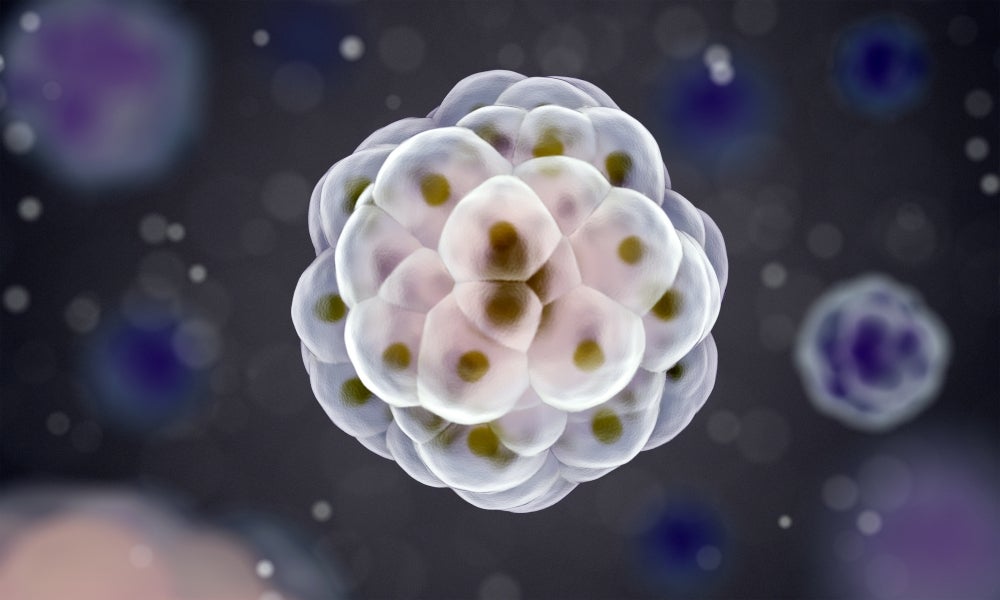
How Stem Cells Make Decisions

If you’re a human embryonic stem cell — and who among us hasn’t been — the G1 (“Gap 1”) phase of development is an important time.
For the first few hours of this phase that occurs within the larger process of the cycle of cell division, you’re deliberating the nature of your existence: Will you keep your options open and remain pluripotent, that is, capable of developing into any type of cell? Or will you commit to becoming part of the tissue that eventually becomes the brain, bone, muscle, or gut?
This crossroads in the cell cycle has been of particular interest to neuroscientist Kenneth Kosik and his research group as they investigate how undifferentiated stem cells take their paths to becoming the specific tissues that comprise the human body, particularly those that become neural precursors.
“If you’re making a tough decision, it takes a little time,” said Kosik, the Harriman Professor of Neuroscience Research in UC Santa Barbara’s Department of Molecular, Cellular, and Developmental Biology.
The mystery deepens when you consider the fact that pluripotent stem cells typically do not make these “decisions” in isolation: One parent cell becomes two daughter cells, which can become four, then eight, and so on. How does the exponentially growing population of sister cells choose their collective fate, ultimately becoming the human being with all the standard body parts and features that humans possess — no more, no less?
It’s a big question. However, Kosik and his group have now uncovered a mechanism that sheds light on, and gives a robustness to, the embryonic development process, while suggesting a new take on the idea of pluripotency. Their research is published in the journal PLOS Biology.
Imperfect Inheritance
A variety of factors are involved in a pluripotent stem cell’s differentiation: genetic cues, environmental influences and a host of other aspects yet to be discovered. Kosik and his team determined in previous research that the duration of the G1 phase was one indicator — the longer the phase, the more likely a neuroectoderm would result, while stem cells with shorter G1s were more likely to remain undifferentiated.
Among the biggest influences on G1 durations are signaling proteins called Wnt (pronounced “wint”), a well-known group of proteins that regulate the proliferation of cells.
“It turns out that the level of Wnt in the stem cell culture media will control the length of G1,” Kosik explained. The more Wnt, the shorter the G1, and the more likely the cells will remain undifferentiated, he said. But a drop in Wnt level extends the length of the phase — which could lead to the formation of neural precursors.
“It sounds sort of binary, but that’s not true,” Kosik said. While it might be logical to assume that Wnt levels exert strict control over the fate of each stem cell via G1 length — and, in addition, that the lengths of G1 in parent cells lead to precisely the same lengths in daughter cells — an interesting phenomenon occurs when the distribution of individual G1 lengths are observed at the single cell level: The percentages of different G1 lengths remains consistent over the entire population. Wnt levels and genetic information might shift the overall likelihood of one cell type over another, but, the researchers found, by no means do they seal the entire population’s fate.
“It’s not perfectly inherited,” Kosik explained. “If a parent cell has a long G1, at least one or both of the daughters are likely to be long. But sometimes one long G1 parent can give rise to two short G1s.” In the same vein, the researchers noted that despite low Wnt levels in the media (which increases the chances of neural precursors), some cells remained stem cells.
“Imagine you have a bucket with all these balls of different colors — red, yellow, orange,” Kosik said. “But suppose I tell you that while they’re sitting there, they interchange their colors, but they always maintain the same proportions, say half red, one fourth yellow and one fourth orange? Suppose I randomly remove 10 or 50 of these balls. When they build back the population, they recreate the same distribution. How would each one know what everyone else is doing, say being orange, for example?”
One explanation for this can be found in the complex relationship of Wnt to the many genes it turns on. For instance, more Wnt is linked to a linear (proportional) increase in the expression of its direct target genes. But the effect of Wnt on G1 duration is exponential, meaning that changes in Wnt at lower levels have far less effect on G1 duration than changes at higher levels.
Collective Probability
“The bottom line here is that when changing the levels of many, many genes and when genes are acting collectively, all together, they now begin to alter stem cell fate in highly non-linear ways,” Kosik said.
These findings, he added, imply that pluripotency is not so much a feature of individual stem cells; rather, it is a quality of the entire population.
“Any individual cell has a defined likelihood of changing to another cell type,” Kosik explained. “But the population in its entirety establishes a collective probability of differentiating based on the state distribution of all its component cells. So, pluripotency is not a single state. It’s actually made up of individual cells, all of them with discrete G1 lengths that together determine whether the cells remain as stem cells or exit pluripotency to undergo differentiation.”
Research in this study was conducted at UCSB also by Jiwon Jang (lead author), Dasol Han, Mahdi Golkaram, Morgane Audouard, Guojing Liu, Daniel Bridges, Stefan Hellander, Alex Chialastri, Siddharth S. Dey and Linda Petzold.



